Immune checkpoint inhibitors have been game changers in tumor treatment during recent years. With improved therapeutic outcomes observed in a variety of solid tumors, this class of drugs has garnered considerable attention. Lacking of mature T, B, and NK cells, Biocytogen B-NDG mice are worldwide recognized as highly immunodeficient tool mice that are ideal for human cell or tissue transplantation. However, the defective immune system of the model itself makes it impossible to evaluate the efficacy of immunotherapy. Immunodeficient mice reconstituted with human immune cells offer a viable solution to this problem: human immune cells and hematopoietic stem cells are transplanted into B-NDG mice or B-NDG-derived mice to reconstitute their immune system, which can better simulate the human immune system for immunological studies and immune drug evaluation.
Biocytogen currently provides three immune reconstitution models: human peripheral blood mononuclear cell (PBMC) reconstitution, human hematopoietic stem cell (CD34+ HSC) reconstitution, and NK cell reconstitution. The immune reconstitution mouse model aids in the efficacy evaluation of immunotherapy drugs, bolstering the efforts in novel drug development and preclinical evaluation.
Anti-CDX tumor efficacy study of antibodies in B-NDG mice reconstituted with human NK cells

Efficacy study of IMAB362 antibody in B-NDG hIL15 mice reconstituted with human NK cells
The humanized B-NDG hIL15 mice model reconstituted with NK cells (2E6) was subcutaneously transplanted with A549-hCLDN18.2 cells (1E6). The mice were grouped 11 days after tumor cell implantation and treated with IMAB362, which showed significant tumor-suppressive effects. The results indicate that the mice provide a powerful preclinical model for in vivo antibody evaluation. Values are expressed as mean ± SEM.

Background
The Immune-deficient B-NDG mouse model (NOD.CB17-PrkdcscidIl2rgtm1/Bcgen) was independently designed and generated by Biocytogen. B-NDG mice are generated by deleting the IL2rg gene from NOD-scid mice with severe immunodeficiency phenotype. Lacking mature T cells, B cells or functional NK cells, and displaying cytokine signaling deficiencies , this mouse model has the highest degree of immunodeficiency and thus is most suitable for engraft and growth of human hematopoietic stem cells (HSCs), peripheral blood mononuclear cells (PBMCs) and human tumor cells or tissues.
• NOD-scid (non-obese diabetes, severe combined immunodeficiency) genetic background: mice of NOD genetic background and with Prkdc (protein kinase DNA-activated catalytic) knockout. Functional T cells, B cells and complement system in these mice are lost, and the activity of NK cells is greatly weakened.
• IL2rg null: the gamma chain of Interleukin-2 receptor (IL-2R γc, also called CD132) is on the mouse X chromosome, and is the common receptor subunit of cytokines IL2, IL-4, IL-7, IL-9, IL-15 and IL-21 with important immune functions. After IL2r is knocked out, mouse immunity function is greatly weakened, activities of NK cells, which are almost completely lost.
• Prkdc null (DNAPK, scid): Prkdc (protein kinase DNA-activated catalytic) null mutation is characterized by significantly deficient of functional T cells and B cells, and an absence of lymphocytes, recapitulating severe combined immunodeficiency (scid) in human patients.
Major Applications
• Human-derived cell or tissue engraftment
• Tumor and tumor stem cell research
• ES and iPS cell research
• Hematopoiesis and immunology studies
• Human infectious disease studies
• Development of humanized models

Animal breeding and maintenance
B-NDG mice are housed in isolators instead of IVCs in our facility. Based on our experience, the mice can live up to 2 months in SPF standard IVCs. This time frame matches the requirements of most experiments performed with B-NDG mice. To improve facility standards, strict sanitation procedures are recommended: cages and bedding need to be sterilized by autoclaving or Co60 irradiation before use, and cages need to be changed in laminar flow hoods weekly. Keeping a clean, high standard housing environment helps to improve the life span of B-NDG mice.
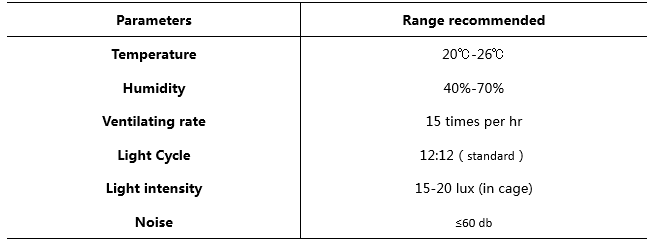
Animal breeding and maintenance
Transportation
Biocytogen’s B-NDG mouse can be shipped using land and/or air. Although the courier is notified to handle the crate with care, stress response of mice during shipment is still inevitable. Although enough supply of water jelly and food will be provided in cages, increased metabolism and fecal excretion caused by the stress may result in dehydration and loss of body weight. General percentage weight loss due to shipment is ~10%. The percentage can be as high as 15% if the shipment procedure is longer and the cage is populated. Usually, the most of the lost body weight is regained (although cannot reach 100%) after 5-7 days of adaptive feeding (Labdiet food is recommended)).
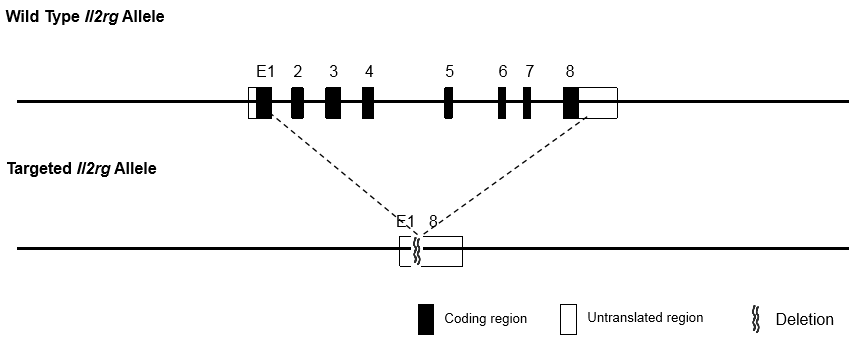
Phenotypic analysis
Body weight growth
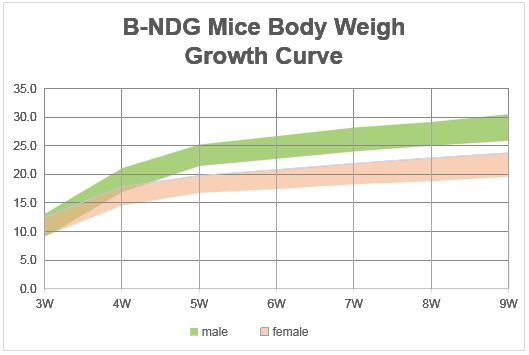

Flow-cytometric Analysis Using Specific Markers for T, B and NK Cells
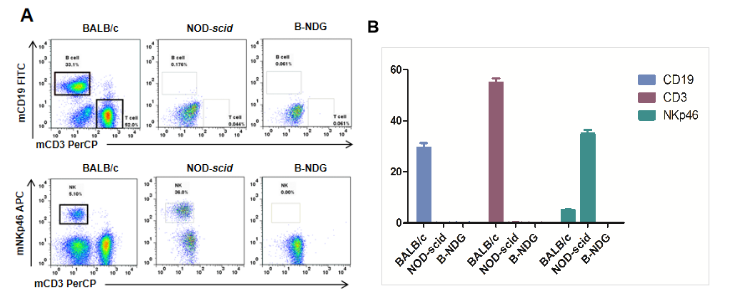
Histology of spleen from B-NDG mice
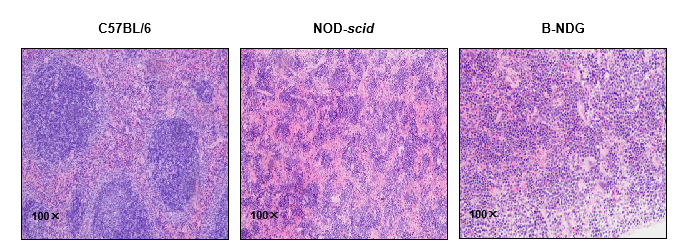
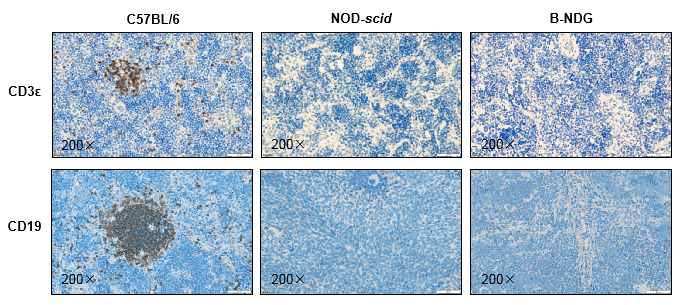
Figure 5. Histological sections of spleen from 9-week-old C57BL/6, NOD-scid, and B-NDG mice (n=3).
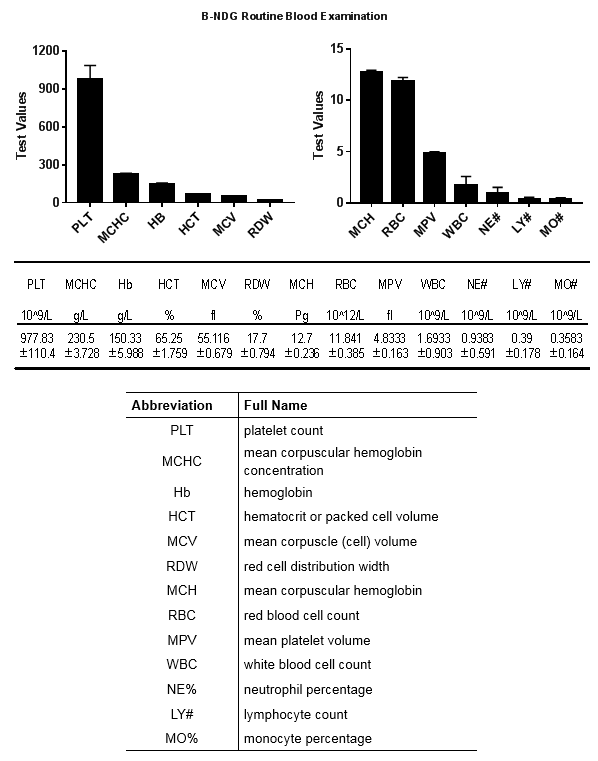
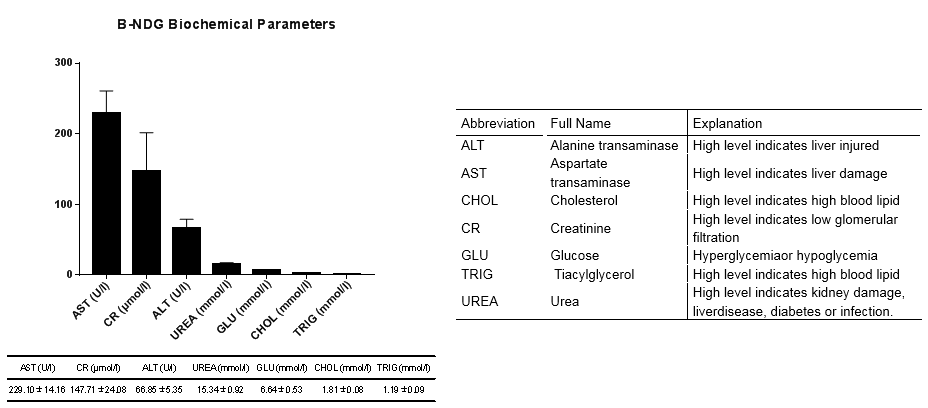
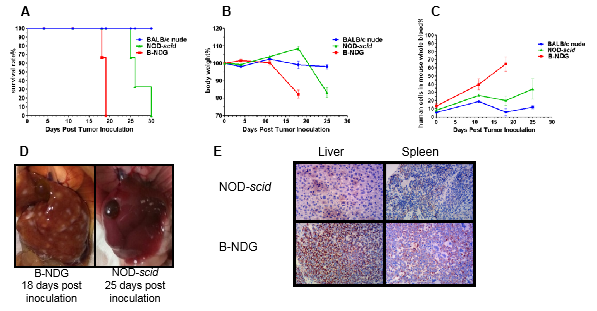
Figure 8. Raji B cells (5X106) were injected in to each B-NDG, NOD-scid and BALB/C Nude mice.
Drug in vivo efficacy study using Raji lymphoma CDX Tumor metastasis model in B-NDG mice.

Figure 9. Raji-Fluc cells (5×105) were injected into B-NDG mice and the same dose of antibody X was given at day 3 and day 10. (A) In vivo imaging recorded at different time points to observe disease progression in mice. (B) Tumor curve for tumor cell fluorescence curves in different groups of mice. The effect of early treatment (at day 3, day 10) is remarkable, and this effect is significantly reduced for the late treatment (at day 10).
Human CD47 antibody in vivo efficacy study using Raji lymphoma CDX Tumor model in B-NDG mice.
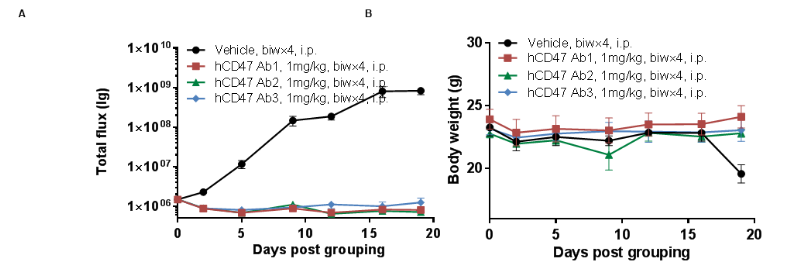
Human B-luciferase-GFP Raji cells (B lymphocytes) were caudal vein implanted into B-NDG. Mice were grouped when the fluorescence intensity reached approximately 1.0E+06 (n=6) at which time they were treated with anti-human CD47 antibodies with doses and schedules indicated in panel A. (A) fluorescence imager was used to monitor tumor fluorescence in mice. (B) Body weight changes during treatment. The results showed that 3 antibodies had efficacies for tumor growth inhibition in B-NDG mice. B-NDG is a powerful model for human CD47 antibody efficacy study. Values are expressed as mean ± SEM.
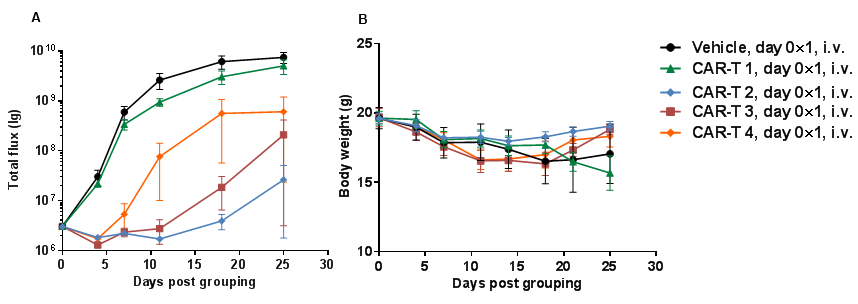
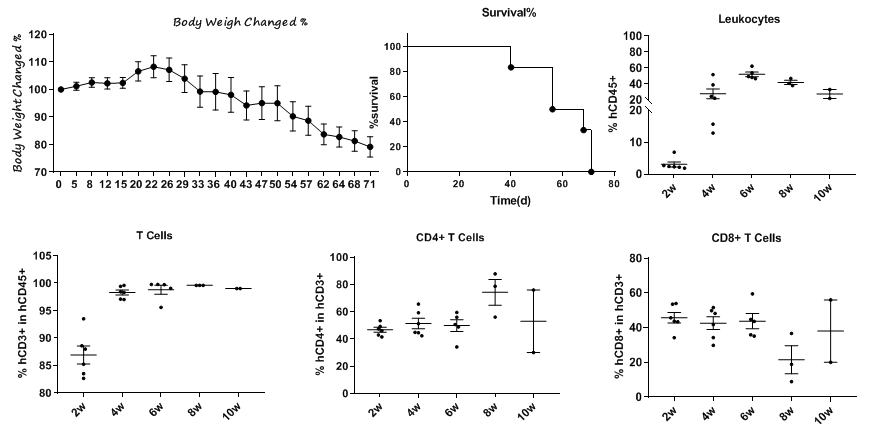
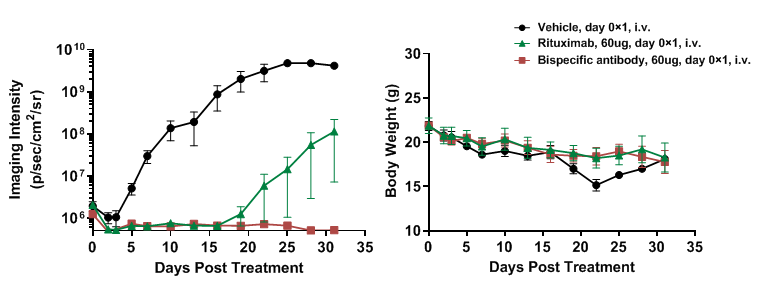
Human B-luciferase-GFP Raji cells (5E5), PBMC (5E6) and antibodies mixture were intravenously injected into B-NDG mice (n=4). (A) fluorescence imager was used to monitor tumor fluorescence in mice. (B) Body weight changes during treatment. Bispecific antibody shows significant inhibitory effects. The results indicate that establishing a CDX tumor model in B-NDG mice with reconstituted PBMCs provide a powerful preclinical model for in vivo evaluation of antibodies. Values are expressed as mean ± SEM.
Human Immune System Reconstituted Models and Efficacy Evaluation
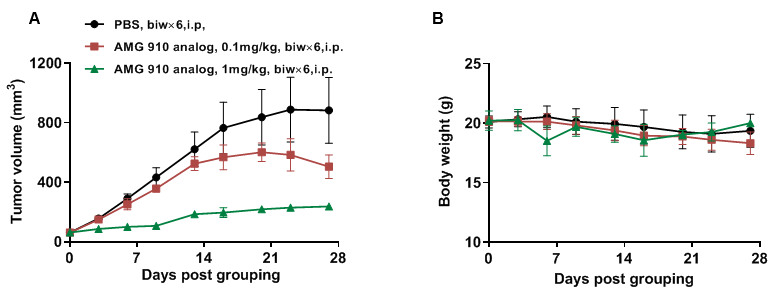
Figure 20. B-NDG mice reconstituted with PBMCs cells were used for CD3×Claudin18.2 bispecific antibody efficacy studies
NUGC4 cells (5E6) were subcutaneously implanted after human PBMCs (5E6) were intravenous implanted into B-NDG mice (female, 7 week-old, n=6). The animals were grouped into control and treatment when the tumor size was approximately 50-80 mm3 and the percentage of human blood hCD45% were above 10%, at which time they were treated with drugs. (A) Anti human CD3×Claudin18.2 bispecific antibody (AMG 910 analog) inhibited NUGC4 tumor growth in human PBMC reconstituted B-NDG mice. (B) Body weight changes during treatment. CD3×Claudin18.2 bispecific antibody shows significant tumor inhibitory effects. The results indicate that establishing a CDX tumor model in B-NDG mice with reconstituted PBMCs provide a powerful preclinical model for in vivo evaluation of antibodies. Values are expressed as mean ± SEM.
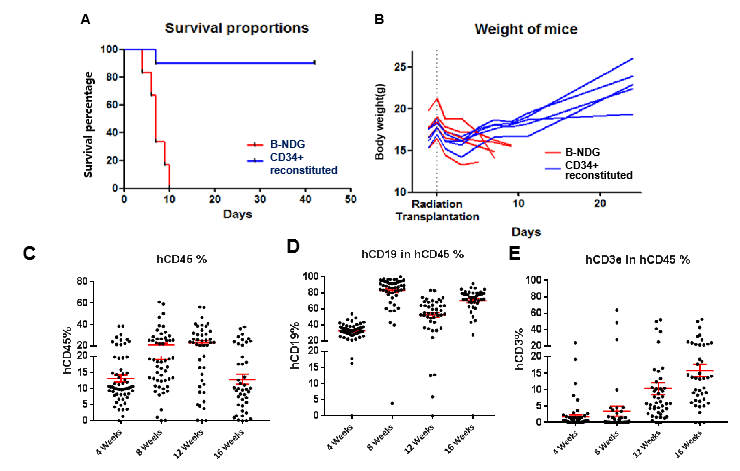
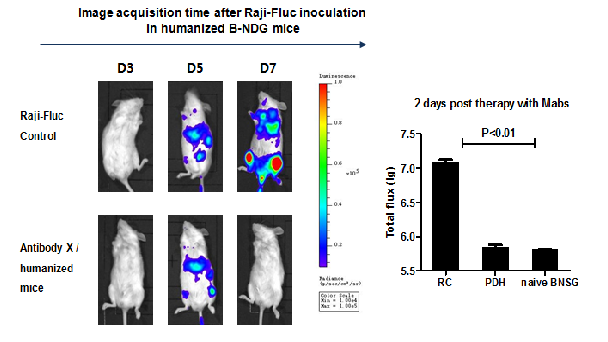
Figure 21. B-NDG mice reconstituted with CD34+ cells were used for drug efficacy studies.









